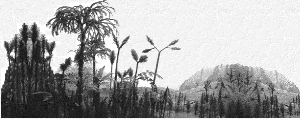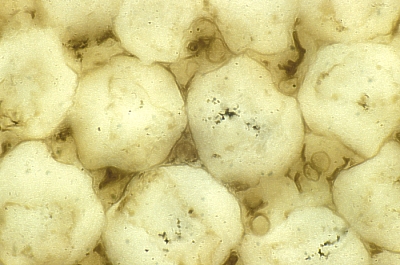

 |
|
 |
 |
Cross sections of
Aglaophyton
axes often show a peculiar dark band, located at three to six cells below
the epidermis. The darker colour is not caused because cells have thicker
walls, but at higher magnifications it becomes clear that it is related
to the presence of mycorrhiza. The intracellular cavities are often
completely filled with fungal hyphae. The fungi lived in symbiosis with
the plant. Such symbioses are very common in extant plants.
Both the plant and the fungus benefit from this mutual relationship. The
fungus extracts organic nutrients from the plant, whereas the latter gets
water and minerals via the fungus. Mycorrhiza fungi living inside the cells of
the plants are called endomycorrhiza. After having penetrated the cell
wall and having entered the cell the fungus normally forms
tree-shaped
outgrowths, the so-called arbuscles, inside the cells of the host
plant.
The exchange takes place at these arbuscles. Although probably 90% of all
modern plants have mycorrhiza, these are very difficult to demonstrate
in fossil material due to their delicate nature. Arbuscles are only
short-living
(up to three days) before they desintegrate as a result of the reaction
of the host plant. There are onyl very few examples of vesicular
arbuscular mycorrhizae (= VAM) in the fossil record, but those associated
with Aglaophyton are unequivocal. The fact that several growth
stages and the typical host reaction can be demonstrated, proves
that the cells in which arbuscles are found were living cells, i.e., that
these fungi were neither saprophytic nor parasitic but
really symbiontic.
The fact that all growth stages of these very short-lived arbuscles are
found indicates that the silicification process must have taken place almost
instantaneously. The entire cycle from the penetration of the cell, to
formation of an arbuscle and finally the decay takes only few days, usually
two or three. VAM have originally been described for Aglaophyton,
but also some other Rhynie Chert plants have these symbiontic fungi.
Also on the overview of the Rhynia axis
illustrated on this website they are clearly visible. The mycorrhizae
associated
with Aglaophyton have been described as Glomites
(Glomaceae).
Although it has repeatedly been suggested that mycorrhiza played an
important
role in the colonization of the land, the Rhynie Chert has first shown
that such symbioses were well established as early as the Early
Devonian.
Above: Fungal hyphae penetrating a lying axis of Aglaophyton; the cuticle of the axis is to be seen below. Middle: Detail of the cortical zone with fungal hyphae (darker) in the intercellualar spaces. Below: A few cells with well developed arbuscles; even the places where the fungus penetrated the cell wall are clearly visible. |
 |
|
 |
| |
| © Forschungsstelle für Paläobotanik, Westfälische Wilhelms-Universität Münster |
April 2000
|